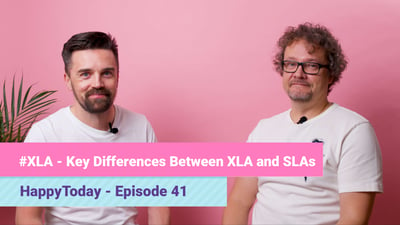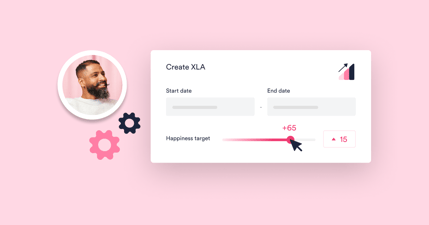Hannah has been working as a Service Management Consultant for TOPdesk for over 7 years, originally focusing on the implementation of tools and technology. However, she stumbled across Experience Level Agreements (XLAs) when realising great implementation never lied solely with the tool itself.
XLA - A broad spectrum
As many people look to define or make sense of what an Experience Level Agreement is, Hannah believes that the topic can not be singled down to a linear definition, as XLAs can become very subjective. This is dependant on how an organisation or IT department aims to use them and what they want to achieve through an outcome metric, like this.
Some people are defining XLA as the experience equivalent of a Service Level Agreement (SLA), and Hannah states this is due to parties 'agreeing' on an Experience Level, just as you would 'agree' on a Service Level.
When you begin to dig deeper into using XLAs, you will start to find that the conversation around using such metrics will widen and slowly incorporate cultural changes within service as well as a change in mindset. This is where creating a tangible agreement around Experience Levels can be challenging.
Thus creating focus away from a fixed 'agreement' and more to Outcome and Experience metrics as well as highlighting the importance of Experience Management.
SLAs miss the mark
Having metrics that just focus on an output will never gather data about the outcome of a project or service - has this added value or had a positive and productive outcome for our end-users?
SLAs keep you in the constant cycle of the watermelon effect - where SLA metrics are achieved and look to be green on the outside, yet cut deeper inside and all you will find is red from the negative experiences witnessed by your end-users.
Hannah writes more about this in her blog - What exactly are XLAs and how do you use them?
If you want to avoid this, start focusing on the feelings, experience and the voice of the end-user, and you will soon find the negative reputation of your IT department or Service Desk changing.
Experience Level Agreements and Experience Management as a whole, will bring an all round view of your IT services, as well as showing the value that Service Desks or your IT department provide to the business.
No one size fits all
After working with many different organisations and helping them integrate experience metrics into their measurement, Hannah claims there is still not a "perfect formula for what XLAs are that fits across the board". Instead, Hannah tailors XLAs to fit specific organisations.
Sami Kallio, HappySignals CEO, always states that working out what you want to achieve or the value you want to add should be figured out first, before you start creating metrics our measurement agreements.
Looking from this way of working also shows that different organisations will have different desired outcomes and goals, therefore also making their XLAs differ.
Furthermore, bringing the end-user into the conversation is a key part of creating XLAs. This will put the end-user at the centre of the discussion and focus directly on their needs and the services that will add value to them.
For example, the Service Desk may have an idea that a certain service or new tech will really add value for the end-user. However, when discussing this service directly with the end-user, they found out that they would in fact not be interested or don't actually need that.
This discussion not only finds out what is beneficial to adding value and productivity to end-users, but it also has saved time, effort and money in avoiding creating a service that won't be used or cause a negative experience.
Furthermore, bringing your end-users into the conversation of XLAs can be a massive step towards happiness and creating and employee-centric culture.
XLA; from Agent through to End-user
If your Service Desk or IT department is offering a happy and engaging service, when fixing IT requests or incidents, this can become highly contagious to the end-user. Even if a ticket is taking long to resolve or the SLA isn't being met due to the end-user being on hold for a long time, they still could have a positive experience through a happy and joyful experience delivered by the end-user.
This points to training Service Desk agents to deliver a happy, positive and joyful experience, seeing their colleagues or end-users as actual human beings, as well as delivering the service in a language that 'non-IT' people will understand. Understanding the level of IT knowledge your end-users (Read more about the Definitive guide to IT Support Profiles) is highly beneficial when delivering a great service.
When an end-user has had a positive experience, they are more likely to deliver positive feedback. This feedback should also be shared with your Service Desk agents as it will also have a highly positive effect on them and make them more motivated to carry out their job.
One of our customers, Region Midtjylland, had this exact scenario happen with them. They were receiving 75% positive feedback and using HappySignals to transparently sharing this with their agents, which heavily increased motivation across their team to continue to deliver an exceptional service.
As as result of this, Service Desk agents satisfaction began to grow in the same way as end-user happiness.
.png)



